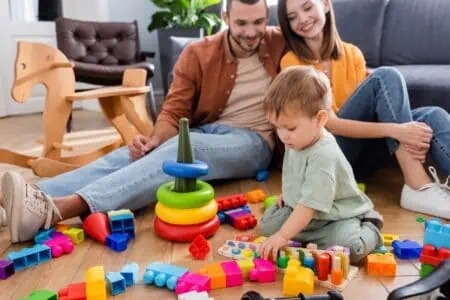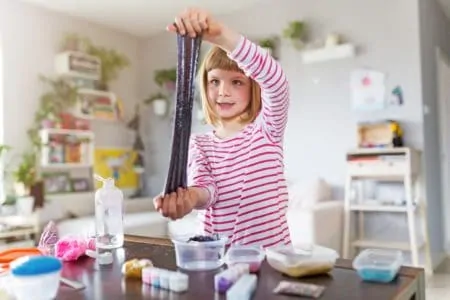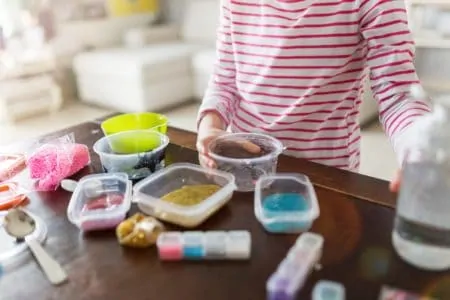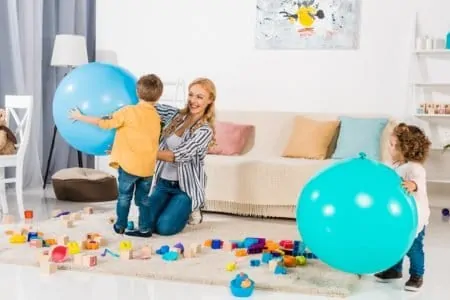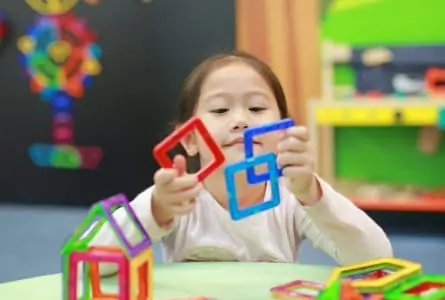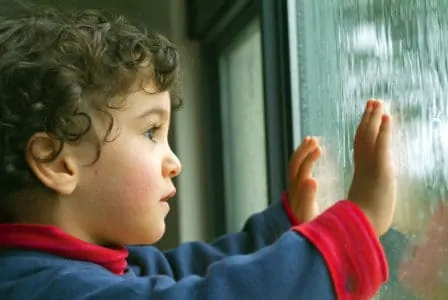Gone are the days when you could lie on the couch with your baby all day long. Around the age of one, babies quickly transform into busy toddlers. They have longer wake windows, endless curiosity, and a need for engagement. It is important to find activities that encourage their development and burn off some of that new energy.
We curated 50 activities for 1-year-olds to keep them entertained while learning vital skills. Whether you want to advance their gross motor skills, boost language, or just survive until nap time, you have come to the right place.
Here is what you need and how to approach each activity. You will soon have plenty of ideas to keep your little one busy.
Key Takeaways
- Build a busy board: Attach items like zippers, latches, and wheels to a wooden board for excellent fine motor skill development.
- Make some noise: Provide pots, pans, spoons, and toy drums for your child to make music and improve coordination.
- Create a drop box: Use an empty tissue box and give your child items to slot into the top for a quick, low-prep activity.
- Stack cups: Offer plastic cups for stacking and knocking over to improve visual motor skills and color recognition.
50 Activities for 1-Year-Olds
Entertaining a one-year-old can be tricky. We put together a list of 50 ideas so you are sure to find a few that work brilliantly for your child.
1. Busy Board
What You’ll Need
- Wooden board (MDF fiberboard works).
- Drill, screws, screwdriver, liquid glue.
- Zippers.
- Latches.
- Doorknobs.
- Handles.
- Wheels.
- Shoelace strings.
A busy board will entertain your child and build their fine motor skills. You can attach almost anything to a busy board. Prop it up somewhere safe and let your child explore the mechanics of the items. If you cannot make your own, you can buy them online.
2. Making Music
What You’ll Need
- Pots.
- Pans.
- Spoons.
- Rattles.
- Toy drums.
Toddlers love making noise! Whether you buy a musical instrument made for toddlers or let them DIY the beats using kitchen utensils, it helps them learn cause and effect. This improves their coordination and encourages experimentation with sound.
3. Drop Box
What You’ll Need
- Empty tissue box.
- Items to drop in the box like crayons, playing cards, or large buttons.
This activity is super easy to prepare when you need to unload the dishwasher or make a phone call. Empty a tissue box and give your child items to slot into the top. Ensure the items are not too small to avoid choking hazards.
4. Stacking Cups
What You’ll Need
- Plastic cups.
Use plastic cups you already have in the house or buy specific stacking cup toys. At this age, toddlers enjoy experimenting with shapes, stacking them up, and knocking them over. This plain old fun improves visual skills and motor skills.
5. Rubber Duck Painting
What You’ll Need
- A few rubber duck toys.
- Paper.
- Paint.
- Painting apron.
Does your little one love bath toys? Turn this into a painting activity by providing non-toxic paint and paper. Prop your child in their highchair with a painting apron and let them dip the duck into the paint. They can stamp the duck onto the paper to create abstract art.
6. Ball Pit
What You’ll Need
A ball pit delights most one-year-olds. It provides sensory stimulation and gross motor practice as they wade through the balls. As they get older, you can use the balls to teach colors and play sorting games.
Top Tip
You need a few hundred balls to ensure the pit is deep enough. We bought 100 balls for our ball pit, and it barely covered the floor surface area. We recommend 400 to 500 balls for the best experience.
7. Homemade Play Dough
What You’ll Need
- Large pot, spoon, wax paper.
- Two cups of all-purpose flour.
- ¾ cup of salt.
- Four teaspoons of cream of tartar.
- Two cups of lukewarm water.
- Two tablespoons of vegetable or coconut oil.
- Food coloring (optional).
Store-bought Play-Doh is generally recommended for age two and up, so make your own taste-safe version from scratch. If they take a bite, it won’t harm them. This sensory activity is best for 15 months onwards and improves finger strength and imagination.
8. Interactive Storytime
What You’ll Need
- Books.
- Props to go along with the book.
Reading is always a good plan, but you can make it more exciting by turning it into an interactive experience. Use puppets or stuffed animals to act out scenes. Ask your 1-year-old what sound the various animals in the book make to encourage vocalization.
9. Sticker Books
What You’ll Need
- Sticker book.
- Large stickers.
At this age, your little one has likely developed their pincer grip. Give them a fun challenge by exploring sticker books together. Choose large, puffy stickers that are easier to peel. Supervise closely to ensure they do not put stickers in their mouth.
10. Scooping Station
What You’ll Need
- Activity table or buckets.
- Spoons.
- Taste-safe items like Cheerios or oats.
- Small toys to hide in the food.
Set up a scooping station using a shallow bin. This is best closer to 18 months, but younger toddlers can experiment with their hands. They learn to scoop items from one bucket to another, which develops fine motor skills and concentration.
11. Egg Carton Straw Puzzle
What You’ll Need
- Empty egg carton.
- Straws or Q-tips.
- Pen or knife to poke holes.
Poke holes in the bottom of an overturned egg carton. Give your toddler straws or Q-tips (cotton buds) to push through the holes. This tricky activity challenges their problem-solving skills and improves hand-eye coordination.
12. Call a Friend
What You’ll Need
Your little one is probably obsessed with your real smartphone. Encourage imaginative play by giving them a toy phone. Pretend to call grandparents, favorite animals, or cartoon characters. Use silly voices to make them laugh and engage in the “conversation.”
13. Drive and Drop
What You’ll Need
- Cardboard box.
- Scissors.
- Toy cars.
Does your little one love cars? Turn it into an interactive game by cutting a slot in a cardboard box. Let your little one drive the car along the “road” before dropping it into the hole (the garage). This simple setup encourages pretend play and works on object permanence.
14. Fridge Magnets
What You’ll Need
- Large magnets.
- Baking sheet (optional).
If you are not into DIY projects, this is a straightforward idea. Let your little one explore fridge magnets and discover what they stick to. You can also give them a metal baking sheet to play with magnets on the floor. This mesmerizes toddlers and can keep them busy while you cook.
15. Jumbo Puzzles
What You’ll Need
- Thick paper.
- Crayons or pens.
- Scissors.
- Or buy a jumbo puzzle.
Start with 2-piece or 4-piece puzzles. You can make your own by drawing something recognizable, like a ball or rubber duck, on a piece of cardboard. Cut it into two pieces and let your toddler put them back together. This introduces the concept of parts making a whole.
16. Peekaboo Puzzle
What You’ll Need
- Wooden peg puzzle.
- Family photographs.
- Glue and scissors.
Cut out photos of family members to fit inside the slots of a wooden peg puzzle. Glue them down so they are hidden when the puzzle pieces are in place. Give the puzzle to your toddler and watch their delight when they lift a piece to reveal grandma’s face.
17. Muffin Tin Sorting
What You’ll Need
- Muffin tins.
- Small toys or safe food items.
- Color sorting items (pom poms, fruit).
Muffin tins are fantastic for basic organizational skills. Our little one loved putting cupcake liners or pretend fruit in the various slots. Encourage them to sort by color, one row for orange items, one for green. This is an early introduction to math and logic.
18. Nature Walk
What You’ll Need
- Appropriate footwear.
- Outdoor clothes.
- A stroller or carrier.
Who says you need to stay at home? Now that your child is mobile, getting outside is a lovely way to pass time. Let them roam around a safe area, pick up sticks, or touch leaves. Bring a stroller in case their little legs get tired.
19. Flashlight Hunt
What You’ll Need
- Flashlight.
Dim the lights and give your little one a kid-safe flashlight. Once they figure out how to turn it on, show them how to shine it on objects. Each time they illuminate something, say the name of the object. This helps strengthen their vocabulary and visual tracking.
20. Ziploc Painting (Mess Free)
What You’ll Need
- Ziploc bag.
- Paper or cardstock.
- Paint.
- Tape.
Do you want to encourage art but avoid the mess? Put a piece of paper inside a Ziploc bag and add a few squirts of paint. Seal the bag tightly and tape it to a table or window. Let your toddler push the paint around with their fingers to create a masterpiece without getting dirty.
21. Water Play
What You’ll Need
- Activity table or sink.
- Water.
- Water-safe toys, spoons, and cups.
Fill a sink or bin with water and dump in toys, spoons, and cups. Let your child pour and splash. You can introduce concepts like “float” and “sink.”
Caution
Always supervise children around water. Accidents can happen in seconds, even in very shallow water.
22. Clothespin Drop
What You’ll Need
- Clothespins.
- Paper towel rolls or a wide-mouthed jar.
Hand your child a few clothespins and a container. Their goal is to drop the clothespins into the container or push them through a cardboard tube. This improves their aim and dexterity. Later, they can practice squeezing the clips to strengthen hand muscles.
23. Sock Puppets
What You’ll Need
- Old socks.
- Buttons, googly eyes, yarn.
- Glue or needle and thread.
Prepare simple sock puppets by gluing on eyes and hair. When telling a story, use the puppet to act out the scenes. Your child might also want to wear the puppet on their hand, which is great for motor control and imagination.
24. Sound Sensory Jars
What You’ll Need
- Clear plastic bottles or jars.
- Fillers: Popcorn kernels, rice, coins, bells, water.
- Superglue (to seal the lid).
Fill plastic bottles with various items to create different sounds. Glue the lids shut securely so your one-year-old cannot open them. Let them shake the jars and listen. This is a safe way to explore small items that would otherwise be choking hazards.
25. Sensory Bags
What You’ll Need
- Heavy-duty Ziploc bags.
- Duct tape.
- Hair gel or water.
- Small toys, glitter, or beads.
Fill a bag with clear hair gel and small toys. Squeeze the air out and double-seal the opening with duct tape. Tape the bag to the floor or high chair tray. Your child can squish the bag and move the items around, exploring texture and cause-and-effect safely.
26. Sticky Wall
What You’ll Need
- Clear contact paper.
- Painter’s tape.
- Lightweight objects (pom poms, tissue paper, feathers).
Tape clear contact paper to a wall with the sticky side facing out. Give your toddler lightweight objects to stick to the paper. They will enjoy sticking things on and peeling them off again. This is excellent for fine motor precision.
27. Obstacle Crawl
What You’ll Need
- Cushions and pillows.
- Crawl tunnels.
- Cardboard boxes.
Create an obstacle course using cushions, tunnels, and open boxes. Challenge your child to crawl under, over, and through the obstacles. This builds gross motor strength, balance, and spatial awareness.
28. Clean Up
What You’ll Need
- Toy bins.
- Small broom or cloth.
Toddlers love to mimic adults. Encourage your little one to help tidy up. Sing a “Clean Up” song and show them where toys go. You can also give them a damp cloth to “dust” the baseboards. It makes them feel capable and involved.
29. Water the Plants
What You’ll Need
- Small watering can or cup.
- Plants.
- Towel for spills.
Children love pouring water. Give them a small watering can and show them how to water plants. Do this outside or prepare for spills indoors with a towel. It teaches care for living things and steadies their hand movements.
30. Spoon and Ball Transfer
What You’ll Need
- Small balls (like ball pit balls).
- Large ladle or serving spoon.
- Two buckets.
Place two containers a few feet apart. Fill one with balls. Show your child how to use the ladle to scoop a ball and walk it to the empty bucket. This requires concentration, balance, and coordination.
31. Fetch Objects
What You’ll Need
- Familiar household items.
Once your child understands basic words, play a fetching game. Ask them to find their shoes, a water bottle, or a specific book. Celebrate when they return with the correct item. This reinforces vocabulary and following instructions.
32. Ball Drop
What You’ll Need
- Balls.
- Cardboard tube or Ball Drop Tower toy.
You can buy a tower toy or tape a cardboard tube to the wall. Let your toddler drop balls into the top and watch them shoot out the bottom. It is a simple lesson in gravity and object permanence that toddlers find endless amusing.
33. Paper Roll Slide
What You’ll Need
- Toilet paper or paper towel rolls.
- Painter’s tape.
- Small balls or pom poms.
Tape empty paper rolls to a wall or door at different angles to create a chute system. Show your child how to drop a pom pom or ball at the top and watch it slide down. Use colorful tape to make it visually appealing.
Warning
Ensure the items you use fit easily through the tubes but are large enough not to be a choking risk if your child still mouths objects.
34. Washing Sensory Bin
What You’ll Need
- Towel.
- Plastic tub with warm soapy water.
- Water-safe toys (like plastic animals or Duplo).
- Sponge or brush.
Fill a bin with tear-free soapy water and toss in some hard plastic toys. Give your child a sponge or brush and let them “clean” the toys. It combines water play with a mimicking activity.
35. Visit the Playground
What You’ll Need
Your one-year-old is likely ready to explore the playground. They may enjoy the baby swings, small slides, or just watching older kids run around. It builds social awareness and encourages physical confidence.
36. Toy Rescue
What You’ll Need
- Laundry basket or plastic bin with holes.
- Yarn or ribbon.
- Toys.
Place toys inside a laundry basket. Weave yarn through the holes to create a “web” over the toys. Challenge your child to reach through the web to rescue their toys. This requires problem-solving and fine motor manipulation.
37. Kid-Friendly Concert
What You’ll Need
- Ear protection (if loud).
- Dancing shoes.
Look for local outdoor concerts or library music sessions designed for kids. The exposure to live music and seeing other children dance is exciting. Your little one can clap, bounce, and express themselves.
38. Hide and Seek (With Objects)
What You’ll Need
- Favorite toy (teddy bear, truck).
Hide a favorite toy in an obvious place, like peeking out from behind a cushion. Ask, “Where is Bear?” and help them find it. As they get better, make the hiding spots slightly harder. This develops working memory.
39. Shape Sorter
What You’ll Need
- Cardboard box and scissors (DIY).
- Or a shape sorter toy.
Shape sorting is a classic toddler activity. It teaches geometry and problem-solving. If you do not have a toy, cut a circle and a square hole in a box and give your child corresponding blocks to push through.
40. Contact Paper Walk
What You’ll Need
- Clear contact paper.
- Tape.
Tape a sheet of contact paper to the floor, sticky side up. Let your child walk or crawl across it with bare feet. The sticky sensation is a unique sensory experience that helps them become aware of their feet and body movements.
41. Card Slot Drop
What You’ll Need
- Oatmeal container or shoe box.
- Knife to cut a slit.
- Deck of playing cards or jar lids.
Cut a thin slit in the lid of a container. Give your toddler playing cards or canning jar lids to push through the slot. Rotating the wrist to align the card with the hole is excellent for wrist dexterity and fine motor control.
42. Sticky Note Peek-a-Boo
What You’ll Need
- Sticky notes.
- Board books or family photos.
Place sticky notes over characters in a book or faces in a photo album. Encourage your child to lift the flap to “find” the person underneath. It mimics lift-the-flap books and refines their pincer grasp.
43. Rainbow Spaghetti
What You’ll Need
- Cooked spaghetti.
- Food coloring and oil.
- Large bin.
This slippery sensory activity is a hit. Cook spaghetti, toss it with a little oil and food coloring, and let it cool. Dump it into a bin. It is safe if they eat it, but mostly they will enjoy squishing, pulling, and exploring the unique texture.
44. Reflection Play
What You’ll Need
- Safe mirror.
Sit your child in front of a mirror. Point to their nose, ears, and mouth. Make funny faces. This helps them build self-awareness and recognition.
45. Balloon Sticky Wall
What You’ll Need
- Contact paper (sticky side out).
- Small balloons.
Stick contact paper to the wall. Blow up small balloons and show your toddler how to stick them to the wall and pull them off. It is visually stimulating and great for reaching and squatting.
Try This
This activity also works with yarn scraps or lightweight tissue paper squares if you do not have balloons handy.
46. Building Blocks
What You’ll Need
Every one-year-old needs a set of blocks. Stacking them and knocking them down teaches balance and gravity. It is the ultimate open-ended toy that grows with them.
47. Sprinkler Fun
What You’ll Need
- Garden hose.
- Sprinkler attachment.
On a warm day, turn on a gentle sprinkler in the yard. Let your toddler run through it or touch the water streams. It provides tactile stimulation and cools them down.
48. Indoor Bowling
What You’ll Need
- Empty plastic bottles or cups.
- Soft ball.
Set up plastic bottles as pins. Roll a ball toward them to knock them over. This strengthens hand-eye coordination and teaches the concept of aiming.
49. Edible Sand
What You’ll Need
- Crackers or graham crackers.
- Food processor.
- Trucks and spoons.
Regular sand can be messy and unsafe if eaten. Blitz crackers in a food processor to create “sand.” Put it in a bin with construction trucks. Your child can scoop, dump, and even snack on the play material safely.
50. Pretend Animal Play
What You’ll Need
- Animal figurines.
Teach your child animal sounds and movements. Hop like a bunny, stomp like an elephant, or roar like a lion. It gets them moving and builds their knowledge of the natural world.
How To Choose an Activity for Your 1-Year-Old
Introduce a range of activities to encourage various skills. Choose activities that build fine motor skills (fingers), gross motor skills (whole body), vocabulary, and focus. Sensory-based activities are also crucial at this stage.
Start with any of our recommendations and observe your child. If they dislike a specific texture or activity, try something else. The goal is engagement and fun, not perfection. Rotate toys and activities to keep things fresh without overwhelming them.
FAQs About Activities for 1-Year-Olds
Helping Your One-Year-Old Thrive
Parenting a toddler is a wild ride. With these 50 activities, you have a toolkit to handle rainy days, fussy afternoons, and developmental milestones.
From sensory bins to gross motor challenges, there is something here for every child. Pick an activity, dive in, and enjoy watching your little one explore their world.
